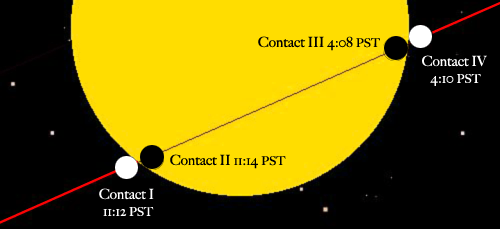
|
|
|||||||||||||||
|
|
||||||||||||||||
| A Mini Eclipse | Sizes of Mercury and the Sun | ||||||||||||||||
|
A Mini-Eclipse
There are four contact times during the transit that astronomers would like to measure. First contact, which is very hard to observe, is the point in time when Mercury first touches the disk of the sun. Second contact is the time when Mercury becomes fully engulfed within the sun’s disk. Third contact is the mirror image of second contact and occurs just before the planet begins to leave the face of the sun. And fourth contact is when Mercury has completely left the sun’s disk. The image below shows the four predicted contact times for Kitt Peak. For a table of approximate contact timings for many other locations, you can go to Fred Espanek’s transit pages . |
||||||||||||||||
|
||||||||||||||||
|
Illustration of Mercury's path across the Sun
|
||||||||||||||||
| Sizes of Mercury and the Sun | ||||||||||||||||
|
||||||||||||||||
| The sun is only 1/2 degree across in the sky. This is like viewing a quarter coin (about 1 inch diameter) placed 9- 1/2 feet from your eyes. Mercury is much smaller still, only 1/200 the diameter of the sun as seen during the transit, only 10 arc-seconds across. This is like viewing that same quarter from 3- 1/2 miles away! This could lead to some serious difficulties for our Webcast. You can easily see the tiny disk of Mercury through a good quality consumer telescope (see " How To View It Safely " section), but we greatly reduce the resolution when we put a TV camera on a telescope. A video signal has only 640x480 pixels of resolution, much less than your eyes. We then take that lower resolution signal and further muddy the waters by making an even lower resolution (320x240) Webcast picture.The JPEG Webcast compression of the video further degrades the image. Fortunately, we are using a 16" telescope which, weather permitting, will give us a a good view. | ||||||||||||||||
| <Back to top | ||||||||||||||||


